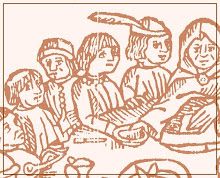I’ve only just started reading it, but I was immediately struck by the style of narration, in which speech is very prominent. It frequently uses direct speech, marked by the use of the first person (note the punctuation of the transcription):
Dixitque. Dimitte me. ut eam hostium obserare. Quia licet minime Deum metuimus. saltem homines opere tali ne superveniant vereri debemus.Direct speech is both frequent and usually marks the emotional and moral crux of each scene. Not only that, but it emphasises speech and its style and effect to such a degree that it would not be an exaggeration to call the whole vita (well, so far as I’ve read) a narrative of speech events.
And she said to him: ‘Allow me to bolt the door: for even if we have no fear of God, at least we should take precautions that no man should catch us in this act.’ (42-43)
- Almost every scene centres around a particular potent occasion of speech.
- Christina’s devotion to Christ is learned and expressed through speech, as is the battle for her mind and chastity.
- The proof of her holiness is in her speech: eg, when young she speaks aloud to Christ in her room at night, in a loud clear voice, believing that no mortal could hear her while she was addressing God.
- Her spiritual education by Sueno is told in terms of his speech and the “colloquium” he had with her. And the elided “cum” in “cum”+“loquor” is appropriate: we are told that he is learning from her speech as much as the other way around.
- Similarly, when trying to force her into marriage, her parents’ primary method of coercion is to keep all religious, god-fearing men from having “colloquium” with her, as if blocking access to the words can keep God away. Instead, she is surrounded examples of bad speech, by “people given to jesting, boasting, worldly amusement, and those whose evil communications [mala colloquia] corrupt good manners [mores bonos]” (47).
- In addition, they set one of her best friends on her, who uses flattery and persuasion and sheer persistence for a whole year to try to persuade her to consent – to that one verbal act that constitutes a contract of betrothal or marriage (depending on verb tense).
- Vows, prayers and moments of verbal consent are the turning points that provide the dramatic structure of the narrative.
- In trying to seduce her, the evil bishop Ralph of Durham uses not force, or even simply words, but explicitly “that mouth which he used to consecrate the sacred species”, neatly demonstrating the moral difference between his speech and hers.
The bishop demands her oath that she would not ‘fail’ but that she indeed lock the door; she swears to it, darts out of the room and locks him in. These happen in reported speech, rather than direct, playing out the suggestions inherent in the direct speech.
Incidentally, the word I’ve rendered above as ‘fail’ is my own translation of ‘falleret’. Talbot, who prefers throughout to read this text as a literal account of her life[2], misses the double meaning here and translates it as ‘deceive him’ – certainly the primary meaning in context, and the only meaning Ralph intends, but I would have preferred to have the ominous hint preserved. To fall truly in this instance, to fail in her vows of virginity, would be to stay in the room with him.
This emphasises the difference maintained throughout the scene between her reading of words (which is largely allegorical) and his (determinedly centred on the physically present). She observes that the door is closed but not bolted (“clausum… sed non obseratum”). Similarly, her chastity is so far defended, but not inviolable. Bolting the door erects a physical barrier between her and her would-be violator, just as there is already a spiritual barrier between them. She has kept her promise she made to him: she has locked the door both physically and spiritually, in a manner far more significant than he intended. She is not forsworn: she adheres to a truth he cannot comprehend.
--------------------
[1] Copying a text, especially with substantial editing, definitely counts as historical writing for my purposes. Oddly, Talbot seems to make little distinction between the original author and the amending copyist – so far as I can tell, as he uses the word ‘biographer’ for both, he seems to assume they’re both from St Albans on the grounds of the same textual evidence (use of “nostrum” etc when referring to the saint or monastery).
[2] He emphasises the biographer’s close relationship to her and the fact that it was written in her lifetime, as well as the paucity of fantastical tales that mark most hagiography of the period, to conclude that it was a genuine attempt at a “history” of the real woman rather than a collection of “stock elements”. I… disagree, mostly with that distinction.


.jpg)


2 comments:
Alright, that was the best spam comment I've ever got:
book said...
God never shuts one door but he opens another.
Unfortunately it had a nasty link in it so I et it, but what a felicitous (and possibly accidentally dirty) tailoring of spam content to post!
I've spend years studying CofM, and never noticed this point about direct speech. How unobservant of me, and how interesting in terms of the 'draft' nature of the text.
Thank you for a very useful blog post!
Joanna Royle
Post a Comment